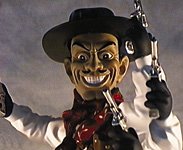| Contact [email protected] |
 |
 |
| Behind The Scenes Pistol Packin' Puppet The Stop Motion Magic Behind Six-Shooter The un disputed and never outgunned star of PUPPET MASTER III is unquestionably Six-Shooter. This dead-aim doll is Andre Toulon's most powerful weapon, a bizarre embodiment of a Hollywood gunslinger who uses multiple ares and tiny pistols to blow away the Axis. The crackling desperado also proved to be the effects crews' most remarkable and demanding creation, requiring several operators, look-alike dolls and intertwinded cables to make him fast on the draw. Like all of Toulon's puppets, Six-Shooter began life in the studios of David Allen as a metal skeleton fitted with ball and socket joints to give him movement. This armature was then suspended in a mold, the detailing fahioned from Six-Shooter's original sculpture. Rubber was then poured in, and after six hours of baking, a menacingly tall body had formed over the metal bones. While paint was being applied to a rubber-yellowed Six-Shooter, costumers fashioned his western apparel in minature with a special red bandanna to hide his devilish smile. One puppet was used by the stop-motion animator, while the main rod doll required five technicians crammed together to handle the arms, body and head. Six-Shooter's most daring scene occurs with the Puppet Master's first act of vengeance, as Toulon sends him scurrying up a three-story brothel to assassinate a Nazi Major. Puppet coordinator John Teska built a special climbing rig to be used on the Universal Studios back lot, where the scene was shot. Strings and pulleys moved Six-Shooter along the building, while an unseen puppet bar controlled the arms. A vaseline-like substance was used on the lens to obscure the wires. To ensure the doll's successful ascent, Teska manuevered Six-Shooter from a hollow building across the street. For Six-Shooter's explosive confrontation with the bewildered German, squibs were rigged inside the tiny pistols to simulate gunshots. A wire then pulled down the bandanna to reveal a cackling grin and the charges were activated. The Nazi managed to get off one shot, and a puppeteer responded by yanking away one arm of the doll. In the end the bullet-filled villain is sent plunging out the window. The special effects process of stop motion animation requires incredible concentration as the puppet is moved ever-so-slightly for each film frame. This occurs at least 24 times during one second of an effects sequence, the payoff being the puppet moving across the screen with no visible means of support. Chris Endicott is one puppeteer who gave life to Six-Shooter. He devised the pistol twirls to revolve three time per frame creating a realistic blur. In the scene where Six-Shooter climbed the building wall, Endicott mounted the full-sized puppet on a horizontal replica of the structure. He then projected footage of the Nazi soldiers behind the doll to make the effect work. So another villain is dead, a cruel laugh echoing in the background as Six-Shooter finds his way home. Return To Behind The Scenes |